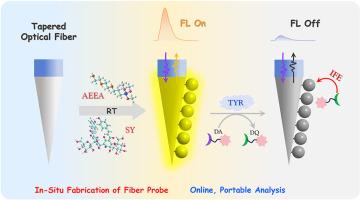原位制备的新型荧光纤维传感器用于酪氨酸酶的超灵敏在线检测。
IF 10.5
1区 生物学
Q1 BIOPHYSICS
引用次数: 0
摘要
灵敏、及时地检测酪氨酸酶(TYR)活性的能力在生物学和临床诊断中至关重要。在这里,我们提出了一种原位制造的荧光光纤传感器,用于灵敏的在线检测TYR活性。该传感器是通过一步原位氧化还原反应制造的,可以在锥形光纤表面直接合成黄发射硅量子点(SiQDs)。该策略有效地避免了复杂的荧光材料合成和与光纤的复杂集成。该传感器具有制备方便、光学性能优异、稳定性好、便携性好、可重复使用、生物样品自身荧光干扰小等特点。通过将TYR触发的多巴胺醌形成与SiQDs荧光猝灭相结合,该传感器实现了对TYR活性的超灵敏、高特异性定量,检测限为0.025 U/mL,线性范围为0.03 ~ 1.0 U/mL。该传感器在实际血清样品中得到了有效的应用,验证了其实用性。这种新型传感器为在线监测TYR活性提供了一种简单、便携和敏感的解决方案。本研究为荧光纤维传感器的制备提供了一种非常实用和高效的方法,促进了其临床和生物学应用。本文章由计算机程序翻译,如有差异,请以英文原文为准。

In-situ-fabricated novel fluorescent fiber sensor for ultrasensitive, online detection of tyrosinase
The ability to sensitively and timely detect tyrosinase (TYR) activity is vital in biology and clinical diagnostics. Here, we proposed an in situ-fabricated fluorescent fiber sensor for sensitive, online sensing TYR activity. The sensor was fabricated via a one-step in situ redox reaction, enabling direct synthesis of yellow-emissive silicon quantum dots (SiQDs) on a tapered optical fiber surface. This strategy effectively avoided the need for complex fluorescent material synthesis and complicated integration with optical fibers. This sensor featured convenient preparation, excellent optical properties, stability, portability, and reusability, with low autofluorescence interference from biological samples. By integrating TYR-triggered dopamine quinone formation with SiQDs fluorescence quenching, the sensor achieved ultra-sensitive and highly specific quantification of TYR activity, featuring a detection limit of 0.025 U/mL and a linear range from 0.03 to 1.0 U/mL. The sensor was effectively employed in real serum samples, confirming its practicality. The novel sensor delivers a straightforward, portable and sensitive solution for the online monitoring of TYR activity. This work provides a highly practical and efficient approach for fabricating fluorescent fiber sensors, advancing their clinical and biological applications.
求助全文
通过发布文献求助,成功后即可免费获取论文全文。
去求助
来源期刊

Biosensors and Bioelectronics
工程技术-电化学
CiteScore
20.80
自引率
7.10%
发文量
1006
审稿时长
29 days
期刊介绍:
Biosensors & Bioelectronics, along with its open access companion journal Biosensors & Bioelectronics: X, is the leading international publication in the field of biosensors and bioelectronics. It covers research, design, development, and application of biosensors, which are analytical devices incorporating biological materials with physicochemical transducers. These devices, including sensors, DNA chips, electronic noses, and lab-on-a-chip, produce digital signals proportional to specific analytes. Examples include immunosensors and enzyme-based biosensors, applied in various fields such as medicine, environmental monitoring, and food industry. The journal also focuses on molecular and supramolecular structures for enhancing device performance.
 求助内容:
求助内容: 应助结果提醒方式:
应助结果提醒方式:


